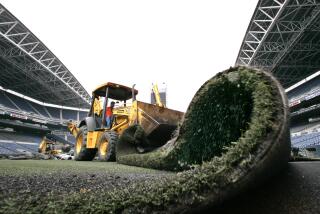Greener Tees
To America’s 6 million golfers, nothing could be more beautiful than a golf course, except perhaps a hole-in-one.
To devout environmentalists, nothing exemplifies a more insidious assault on the landscape. Conservationists charge that golf course development causes massive disruption of the natural topography, destroys wetlands and wildlife habitat and pollutes lakes and streams with pesticide and fertilizer runoff.
The $20-billion golf industry is working to clean up its act and brighten an image tarnished by the deaths of flocks of Canada geese poisoned by pesticides on courses in the 1970s. Between 1991 and 1995, the U.S. Golf Assn. spent more than $5 million to research the environmental dangers that golf courses pose to the environment, and to develop drought- and disease-resistant strains of turf grasses.
And in 1991, the USGA found a valuable public relations ally in the Audubon Society of New York State Inc., which dishes out sound environmental planning in user-friendly packages for new and established golf courses.
Currently, approximately 10% of the 12,000 golf courses nationwide belong to the USGA-funded ASNYS Inc. Sanctuary program. Shown here are several ways to create a “greener” golf course.
1. Water Conservation
On-site weather stations measure turf moisture content and irrigation systems release water only when and where needed. Older courses, such as the 100-year-old Los Angeles Country Club, contract with outside weather stations, such as one at UCLA. Reseeding with drought-tolerant grasses, which require less water, and revegetating with native plants around the fairways also cuts water consumption.
2. Pest Management
Birdhouses are installed to attract insect-eating birds. Beneficial insects and worms are introduced into the course to control infestations. Insect populations are monitored carefully. Spraying is a last resort, to be used only when conditions indicate an infestation. At the Saticoy Country Club in Somis, a member of the Sanctuary program, pesticide use is down 80%.
3. Tougher Turf
The USGA has funded 90 research grants at more than 30 universities nationwide to develop turf, including warm-weather Bermuda and bent grasses. Some are being genetically altered to resist disease by the introduction of a gene that makes the grass impalatable to destructive pests. Salt-tolerant strains allow for the use of effluent water.
4. Wildlife Habitat Conservation
The “rough” areas of the course surrounding greens and fairways are revegetated with native plants to provide cover and food for surrounding wildlife. Ideally, a wildlife corridor snakes along the course from the outer perimeter to the ponds, providing cover all the way to a water source. Ponds are kept clean by the introduction of specific plants to control algae and produce oxygen.
Local examples of environmentally friendly golf courses
* Proposed Signature Sanctuary courses: Los Angeles Golf Course, Tujunga; Hunter’s Green Project, Santa Clarita.
* Three city-owned golf courses in Sepulveda Basin will be equipped to use effluent water.
* Saticoy Country Club Somis
* Los Olivos Golf Course, Ventura
* Los Angeles Country Club
Sources: Audobon Society of New York State, Inc.; U.S. Golf Assn.; Golf Course Superintendents Assn. of America; Researched by MAGGIE BARNETT / Los Angeles Times
More to Read
Sign up for Essential California
The most important California stories and recommendations in your inbox every morning.
You may occasionally receive promotional content from the Los Angeles Times.










